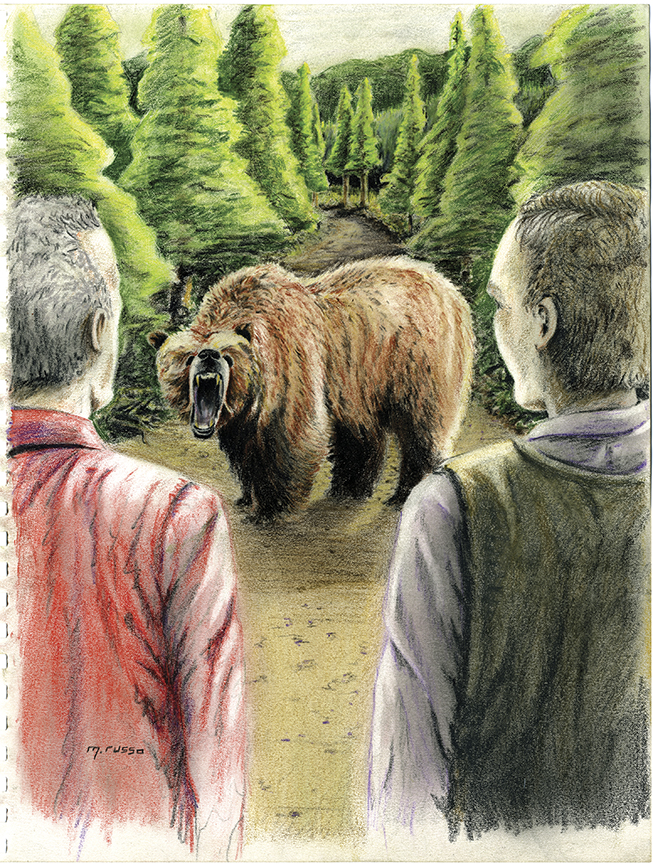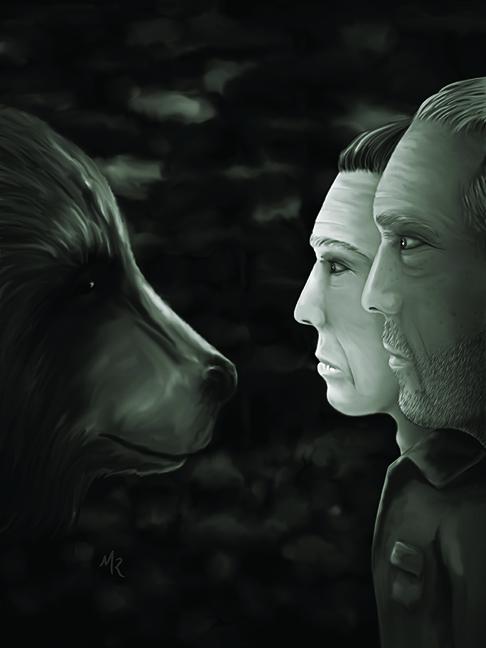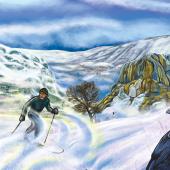Old Ephraim
A Yellowstone grizzly encounter.
Every year, in September or October, my friend Chuck and I paddle the 20 miles down to the Southeast Arm of Yellowstone Lake. It is our autumn pilgrimage to a place like no other on Earth. The Southeast Arm is where the Yellowstone River flows into the lake out of the Two Ocean Plateau and the Absaroka Mountain Range. Canoe-tripping on Yellowstone Lake is a chancy thing with the winds of autumn and cold water, but we worked together as smokejumpers and have known and trusted each other for a long time.
We fish for cutthroat trout and watch the frantic antics of breeding elk. The Southeast Arm is a wetland, two and a half miles wide and four miles long. The river flows flat and meandering with many old oxbows cut off from the main channel. Waterfowl by the thousands churn up the shallow bottoms, fattening up on the water plants in preparation for the long flight south. The rich wetland has unbelievably high productivity for such a brief growing season at 7,733 feet in elevation.
At first morning light we load the 18 1/2-foot, 65-pound Sitka spruce strip canoe. The launching point is on the east side of Yellowstone Lake, near where the highway leaves the lake shore and heads east toward Cody. I built the canoe ten years ago and something uncommon happened: it came out perfect. This has not been the case with many of my boats. The keel line is straight as a string, with no rocker. It’s fast. A greyhound of the lakes. When I kneel in the stern, I feel like I’m back on my old destroyer.
Chuck’s lower back and legs are disabled, but he is a strong paddler. It took us all day to paddle down the east shore to the inlet of the Yellowstone River. The weather was clear with no wind. The lake was kind to us that day. Yellowstone Lake can be deadly this time of the year with high winds, steep waves, and cold water. The east shore is wide open and exposed to the full sweep of the prevailing west wind. We have been blown off the lake several times and I constantly worry about it. Last October, I had to paddle down alone, because Chuck did not feel up to going. I swamped the 15-foot solo strip canoe in the high wind and waves. I would have lost my life, had I not worn my wetsuit to insulate against the cold water. The wind pushed me and my water-filled canoe into the rock cliffs off Park Point. I lost some precious equipment and damaged my canoe. It was a hard-learned lesson that taught me never to take chances on the big lake.
We paddled hard all day to finally make the 20 miles down to the Southeast Arm and make camp. We were able to catch a few trout in the fading light and I cooked them up with onions and potatoes. We ate fish by flashlight until we were full, then washed it down with coffee. The night air was clear and cold, no mosquitoes, so we had no need to set up the tent. I hung all of our food 25 feet up, out of bears’ reach. The elk were in full breeding activity. Their bugle music and deep grunting filled the night air. About 2:00 am a bunch came through camp and ran splashing down the beach. I don’t know what all this grunting and snorting amounts to deep in the mystery of night, but the elk did not seem to mind us lying out under the dry trees. I hoped one would not mistakenly step on us in its high fever, but I also knew an elk knows exactly where his feet are at all times and is not likely to make mistakes or do anything foolish.
When the eastern sky began to brighten, I got up and retrieved our hanging food. I rebuilt the fire and reheated what was left of the fish and potatoes. Chuck began his laborious process of getting up. About 12 years ago he was thrown from a dangerous horse. He landed on his back across a log, broke his back, and life has been a nightmare of pain ever since. He came through the deep winter battles of Korea without a scratch, but it took a jug-headed Forest Service horse to do him in.
The sun was beginning to warm the morning chill and dampness. Breakfast was dry cereal mixed with powdered milk and we finished off the last of the fish and coffee. After breakfast we re-hung our food and decided to walk down to Trail Creek Meadows, where the elk put on their morning breeding show. We shuffled down the flat trail with the anticipation of watching the big bulls push each other around, something like Saturday night at the local bars in Gardiner. Chuck and I have had our fill of that kind of nose-flattening dance and were now content to sit on the sidelines and watch. It is an age-old ritual that can be depended on to happen, as long as there are cows and bull elk, and young men and beer.
We began to see bear tracks in the wet mud of the trail. After walking through an open wet meadow, we came upon two large piles of grizzly dung. It looked like it came from an elephant! There was a flat wetland to our left and a steep open burnt slope to our right. The fires of 1988 had passed through here and left many downed trees. The Park Service had sawed out the trail, which was now a narrow corridor with a shintango of downed logs six to eight feet high on both sides of the trail.
We came to a small creek-crossing about a mile from camp. I stopped at the water’s edge and reached into my shirt pocket for the USGS contour map to show Chuck where we were located. Chuck was looking over my shoulder as I pointed out to him that we were at this unnamed creek (now forever etched into my mind as Ephraim Creek), when I heard Chuck exclaim, “Look at that!” Chuck is a cool person, not given to excitement or exaggeration. From the sound of his voice I sensed something serious was happening.
I looked across the small creek and, standing on a six-foot rise on the trail a little over 10 yards away, was the largest grizzly I have ever had the misfortune to see at so close a distance. I don’t know how long he waited there staring down at us as we approached. He looked like the king of the hill at the top of the push-and-shove society. I instantly knew that we were too close, intruding into his space, and I told myself, “It’s a big male and he ain’t going to give up the trail.” I was convinced that he was going to roll right over us. I stared into those little eyes set in a head as large as a bushel basket. He had no collar and no identifying ear tags. He was an untouched wild bear. He turned with his left foot on a stump and showed us his best side. He did not have to do that with me. I was already convinced that his best side was better than either of mine.

I could clearly see the large hump and the dark fur chaps on his front legs. His pelt was bright and shiny. He was at the peak of health, beautiful in a lethal way, and I was terrified of what he would do to us. I heard Chuck slowly say into my left ear, “Turn around and go back.” That was the best advice I’d heard all morning. Actually, I couldn’t stand to look at him any longer without reducing myself to gibberish. We slowly turned and began to shuffle back down the trail. Chuck was in the lead and I was between him and the bear. We made about 30 feet when I summoned up the nerve to look over my right shoulder at the bear. He was now coming down the bank to cross the creek where we had stood just seconds ago.
I said, “Chuck, he’s coming.” Chuck picked up the pace as best he could and I followed close behind with my hands practically on his shoulders. If we had tripped and fallen at that time, I think the bear would have walked over the top of us. I took another look, dreading what I would see. The bear was still following and I thought I saw him break into a lope. My hair stood up on the back of my neck as I became certain he was going to hit me between the shoulder blades. In a panic, I said, “Chuck, turn left, we’ve got to get off the trail.” It was an impossible request. Chuck could not climb over the pile of cut logs that lined both sides of the trail. He responded by shouting back, “Show me where, show me where!”
We continued to shuffle down the trail, stepped over the two dung piles, and finally came into the open meadow. Without looking back, we turned left and began to scramble up the steep slope. Tripping and falling, we climbed about 200 feet to a break in the slope that formed a small bench. Out of breath, I knew we could go no further. This is where we had to make our stand against the bear. I looked back down the slope to the trail where it came out of the timber: no bear. The pressure was off, at least for now.
I frantically looked around the bench for something Chuck could climb. I saw nothing but fire-blackened lodgepole pine trunks with no branches for 50 feet. I ran over to the only green thing on the bench. It was an alpine fir that somehow had escaped the fire and was growing out of the ground in a fork of two trunks. Chuck came over and I told him to get his knees on one trunk and his back on the other trunk and chimney-climb the tree. He took off his day pack and began to climb. I looked back down for the bear. No bear. I immediately felt some relief. Chuck continued to chimney up the tree and was about 12 feet up. My confidence began to return. If Chuck could get up to 20 or 25 feet, I could then shinny up a burnt lodgepole and maybe we could save ourselves. Chuck continued climbing with difficulty.
I looked back down the slope. The bear came out of the timber on the trail and turned left, just as we had done minutes before. He was climbing up the hill in our tracks. I said, “Chuck, he’s coming up the hill.” Chuck promptly fell out of the tree and lay on his back at the foot of the fir. I watched the bear coming up the slope not 150 feet away. At this point I did not know what to do and felt defenseless.
The bear began to angle off, still climbing, but beginning an uphill contour on the steep slope. He passed within 75 feet of us and I will never forget this: he looked twice at me, over his left shoulder, as if to say, “Relax, I’m not interested in you two nerds.” He continued side-hilling up the slope and around the ridge out of sight. Chuck was on his feet. I said, “He’s going around the ridge to come at us from above.” We agreed to go directly down the hill, across the trail, and into the wetland where there were two large, unburned spruce trees with branches touching the ground.
We floundered down the slope and climbed into the thick spruces. We roosted there for a time until I felt foolish. That big devil was long gone. He knew exactly where he was going. He was contouring uphill so that he would be a safe distance from the Trail Creek patrol cabin as he traveled toward the west. He had his route planned out and he was unwilling to change it for us. If he did not have to touch us, well, so much the better. He was confident in his power and all he wanted was for us to get out of the way. His delay at the dung piles allowed us to scramble up the steep slope and get out of his way.
We were lucky that it wasn’t a female bear or a female with cubs. They get pushed around a lot by other bears and become belligerent and over-protective. That big male was a gentleman and mercifully let us off the hook. I went back to Ephraim Creek the next day and measured the distance between us and the bear when we first encountered him. It was 35 feet. It took a very confident bear to allow us to get that close within his space and not attack. He was truly a wild bear, untouched by Park biologists. The Southeast Arm of Yellowstone Lake is a long distance from any trailhead and the bears in that area have little contact with humans. I was surprised that we encountered a bear in this place in September; they are usually up above 8,500 feet in elevation, robbing whitebark pine nuts from squirrel caches and putting on fat for the winter hibernation.
When we returned to camp there were sounds of activity at the patrol cabin, which was located a half-mile west of our camp. That night our sleep was less than restful. We talked endlessly over the details of our bear encounter. In the morning, a group of uniformed Park Service rangers on horseback came by on the trail, all wearing .357 magnum revolvers on their hips. They explained that there was some trophy poaching going on up in the Thorofare country and they were going to look into it. I did not say anything about our bear encounter with all of that artillery showing. Hopefully our big bear will continue to avoid humans and go on his peaceful way, with no hard feelings on either side.













